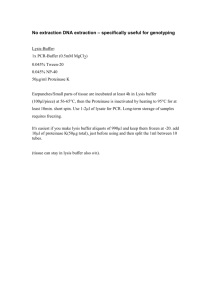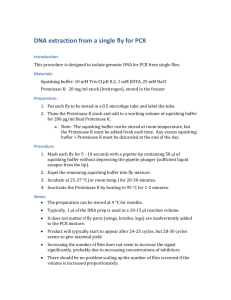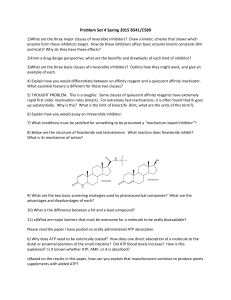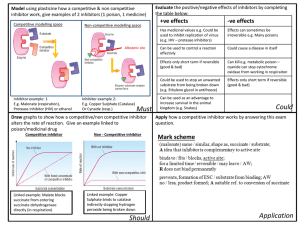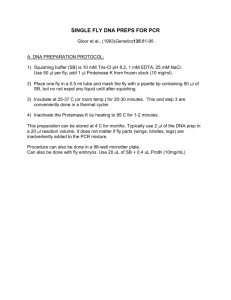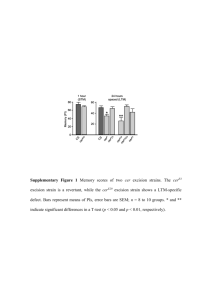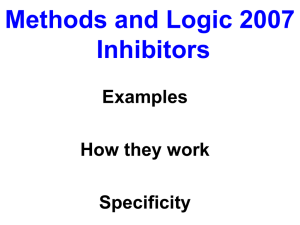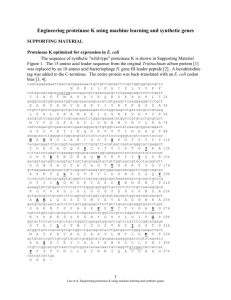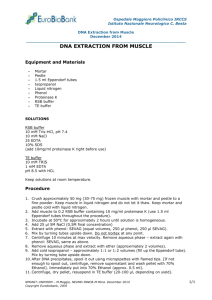Populus Potential of Proteinase Inhibitors for Enhanced Resistance to Arthropod and Pathogen Pests
advertisement
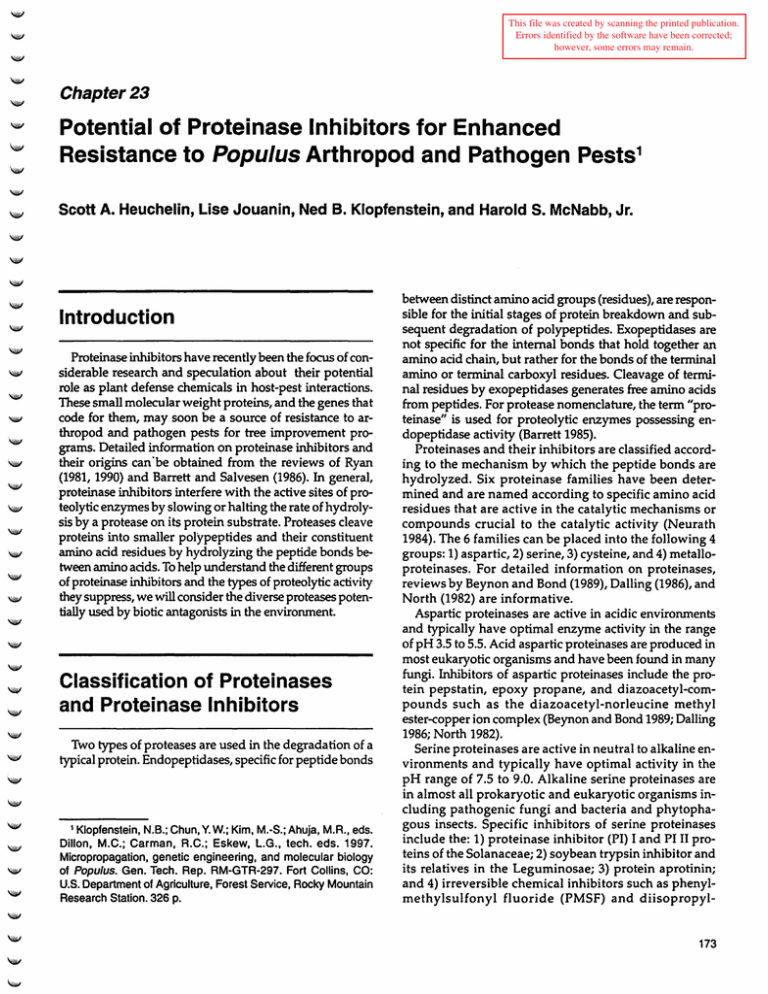
This file was created by scanning the printed publication.
Errors identified by the software have been corrected;
however, some errors may remain.
Chapter23
Potential of Proteinase Inhibitors for Enhanced
Resistance to Populus Arthropod and Pathogen Pests 1
Scott A. Heuchelin, Lise Jouanin, Ned B. Klopfenstein, and Harold S. McNabb, Jr.
Introduction
Proteinase inhibitors have recently been the focus of considerable research and speculation about their potential
role as plant defense chemicals in host-pest interactions.
These small molecular weight proteins, and the genes that
code for them, may soon be a source of resistance to arthropod and pathogen pests for tree improvement programs. Detailed information on proteinase inhibitors and
their origins can 'be obtained from the reviews of Ryan
(1981, 1990) and Barrett and Salvesen (1986). In general,
proteinase inhibitors interfere with the active sites of proteolytic enzymes by slowing or halting the rate of hydrolysis by a protease on its protein substrate. Proteases cleave
proteins into smaller polypeptides and their constituent
amino acid residues by hydrolyzing the peptide bonds between amino acids. To help understand the different groups
of proteinase inhibitors and the types of proteolytic activity
they suppress, we will consider the diverse proteases potentially used by biotic antagonists in the environment.
Classification of Proteinases
and Proteinase Inhibitors
Two types of proteases are used in the degradation of a
typical protein. Endopeptidases, specific for peptide bonds
1 Klopfenstein, N.B.; Chun, Y. W.; Kim, M.-S.; Ahuja, M.A., eds.
Dillon, M.C.; Carman, R.C.; Eskew, L.G., tech. eds. 1997.
Micropropagation, genetic engineering, and molecular biology
of Populus. Gen. Tech. Rep. RM-GTR-297. Fort Collins, CO:
U.S. Department of Agriculture, Forest Service, Rocky Mountain
Research Station. 326 p.
between distinct amino acid groups (residues), are responsible for the initial stages of protein breakdown and subsequent degradation of polypeptides. Exopeptidases are
not specific for the internal bonds that hold together an
amino acid chain, but rather for the bonds of the terminal
amino or terminal carboxyl residues. Cleavage of terminal residues by exopeptidases generates free amino acids
from peptides. For protease nomenclature, the term "proteinase" is used for proteolytic enzymes possessing endopeptidase activity (Barrett 1985).
Proteinases and their inhibitors are classified according to the mechanism by which the peptide bonds are
hydrolyzed. Six proteinase families have been determined and are named according to specific amino acid
residues that are active in the catalytic mechanisms or
compounds crucial to the catalytic activity (Neurath
1984). The 6 families can be placed into the following 4
groups: 1) aspartic, 2) serine, 3) cysteine, and 4) metalloproteinases. For detailed information on proteinases,
reviews by Beynon and Bond (1989), Dalling (1986), and
North (1982) are informative.
Aspartic proteinases are active in acidic environments
and typically have optimal enzyme activity in the range
of pH 3.5 to 5.5. Acid aspartic proteinases are produced in
most eukaryotic organisms and have been found in many
fungi. Inhibitors of aspartic proteinases include the protein pepstatin, epoxy propane, and diazoacetyl-compounds such as the diazoacetyl-norleucine methyl
ester-copper ion complex (Beynon and Bond 1989; Dalling
1986; North 1982).
Serine proteinases are active in neutral to alkaline environments and typically have optimal activity in the
pH range of 7.5 to 9.0. Alkaline serine proteinases are
in almost all prokaryotic and eukaryotic organisms including pathogenic fungi and bacteria and phytophagous insects. Specific inhibitors of serine proteinases
include the: 1) proteinase inhibitor (PI) I and PI II proteins of the Solanaceae; 2) soybean trypsin inhibitor and
its relatives in the Leguminosae; 3) protein aprotinin;
and 4) irreversible chemical inhibitors such as phenylmethylsulfonyl fluoride {PMSF) and diisopropyl-
173
Section IV Biotic and Abiotic Resistance
phosphofluoridate (DIFP) (Beynon and Bond 1989;
Dalling 1986; North 1982).
Cysteine proteinases are a diverse group and are active
in environments with widely ranging pH values. Optimal activity has been observed from pH 4.0 to 8.0, depending on the organism and its environment. Cysteine
proteinase activity is typically activated or enhanced in
the presence of cysteine, low molecular weight thiol
groups, and other reducing agents. This group of proteinases has been found in almost all organisms including
phytophagous insects. To date, reports of cysteine proteinases in fungi are few. Specific inhibitors of cysteine
proteinases include the OCI (oryzacystatin) protein of rice,
iodoacetamide, iodoacetate, N-ethyl maleimide, and
heavy metals (Beynon and Bond 1989; Dalling 1986; North
1982).
Metallo-proteinases are typically active in near neutral pH environments; however, some metallo-proteinases have optimal activity in pH conditions as low as
pH 5. Most metallo-proteinases contain a crucial zinc
atom within their catalytic site. These proteinases are
widespread in prokaryotic and eukaryotic organisms
including some pathogenic fungi. Inhibitors of metalloproteinases include phosphoramidon, hydroxamic acid
derivatives, mercaptoacety ldipeptides, ethylenediaminetetraacetic acid (EDTA), and other metal-chelating agents
(Beynon and Bond 1989; Dalling 1986; North 1982).
Of these inhibitors, the small molecular weight proteins are of particular interest to researchers. Usually
these inhibitor proteins are tight-binding reversible inhibitors of their proteinase class that have little reactivity with other types of proteinases. Since they are
reversible inhibitors and follow an equilibrium dissociation constant, their activity is dependent on their
concentration in the system studied. Because they have
exhibited almost no toxicity to nontarget organisms, and
their affect on the target organism is rarely acute, they
are ideal for biological systems.
Of even greater interest, is the potential to create
transgenic trees that can express inhibitor proteins in
their leaf, root, and I or cambial tissues. Once the gene
for a particular inhibitor protein is cloned, it can be incorporated into a transformation vector and used to
create transgenic trees that may possess higher resistance to a particular arthropod or pathogen pest
(Klopfenstein and Hart 1997). Research in this direction was recently initiated using Populus as a model
transformation system for woody plants. Overall, such
research has focused on 2 inhibitor proteins; PI II, a
serine proteinase inhibitor from potato (Heuchelin et
al. 1997; Klopfenstein et al. 1991, 1993, 1997) and OCI
(Cornu et al. 1996; Leple et al. 1995). A summary of the
research conducted with these inhibitors, including
transformation and expression studies, pest susceptibility assays, and in vivo resistance bioassays follows.
174
Expression of the Serine
Proteinase Inhibitor, PI II,
in Poplar
The serine proteinase inhibitor, PI II, is a low molecular
weight protein (monomer Mr 12,300) (Plunkett et al. 1982)
that exists in dimeric form and inhibits the proteolytic activity of trypsin and chymotrypsin (Ryan 1981, 1990; Ryan and
An 1988). PI II is the gene product of the proteinase inhibitor
II (PIN2) gene, which was first cloned from tomato and potato (Graham et al. 1985; Sanchez-Serrano et al. 1986).
In theory, PI II could effectively reduce the vigor of fungi
by depriving them of necessary amino acids (Ryan 1990).
Lorita et al. (1994) proposed the use of proteinase inhibitors as a novel class of fungicides after observing deleterious effects of serine proteinase inhibitors on fungi. A similar
study at Iowa State University (I.S.U.) using PI II, supports
the fungistatic effects of serine proteinase inhibitors
(Heuchelin and McNabb 1995). Proteinase inhibitors have
reduced the activities of fungal proteinases in
Colletotrichum lindemuthianum (Mosolov et al. 1979) and
Fusarium so/ani (Mosolov et al. 1976 ). Our studies show
that Mycosphaerella populorum (Septoria musiva anamorph)
produces proteinases in vitro that are inhibited by PI II
(Heuchelin and McNabb 1995). Proteinases also have a
significant role in the pathogenesis of host tissues.
Movahedi and Heale (1990) concluded that proteinases
may act synergistically with the cell wall degrading enzymes in pathogenesis. Inhibition of these proteinases may
reduce infective capacity, colonization, and sporulation of
the fungus. Reductions in any of these areas could slow
fungal spread decreasing disease pressure.
Insect growth, development, and reproduction are also
potentially influenced by PI II. PI II in the diet of insect
species reduced growth in Heliothis zea and Spodoptera
exiqua (Broadway and Duffey 1986), and Manduca sexta
(Johnson et al. 1989). A potential role of PI II in resistance
to arthropod pests is apparent.
Hybrid poplar clones cv. 'Ogy' (Populus x euramericana)
and cv. 'Hansen' (P. alba x P. grandidentata) were used in
studies at I.S.U. and the USDA Forest Service National
Agroforestry Center (NAC). In North America, the major
defoliating insect pest of 'Ogy' and other Populus hybrids
of Aigeiros parentage is the cottonwood leaf beetle,
Chrysomela scripta (Coleoptera: Chrysomelidae). Although
C. scripta is not a major pest of 'Hansen' and other hybrids
of the Leuce (currently termed Populus) section, the imported willow leaf beetle, Plagiodera versicolora (Coleoptera:
Chrysomelidae), can cause considerable defoliation and
is a major pest of white poplar, aspens, and their hybrids
(Ostry et al. 1989).
USDA Forest Service Gen. Tech. Rep. RM-GTR-297. 1997.
Potential of Proteinase Inhibitors for Enhanced Resistance to Populus Arthropod and Pathogen Pests
To study PIN2 gene expression, poplar clones were transformed with an Agrobacterium binary vector system. Initially, 'Hansen' was transformed with the binary vector
plasmid pRT45 to test the wound-inducible PIN2 promoter
with the chloramphenicol acetyl transferase (CAT) reporter
gene. Using northern analysis, these studies demonstrated
inducible expression of PIN2-CAT when leaves were artificially wounded (Klopfenstein et al. 1991).
To test the importance of proteinases in host-parasite
interactions, transgenic 'Ogy' and 'Hansen' were produced containing a chimeric fusion of the PIN2 structural
gene with the cauliflower mosaic virus 35S or bacterial
nopaline synthase (NOS) promoter (Heuchelin et al. 1997;
Klopfenstein et al. 1993, 1997). An Agrobacterium binary
vector system, containing either the pRT102 or pRT104
transfer DNA (T-DNA) vector and a disarmed tumor-inducing (Ti) plasmid (EHA 101) as the helper plasmid, was
used to transform poplars with PIN2 gene constructs. The
T-DNAalso included a NOS promoter linked to a neomycin phosphotransferase (NPTII) gene as a selectable
marker (Heuchelin et al. 1997; Klopfenstein et al. 1997).
The PIN2 coding region is regulated by a NOS promoter
in vector plasmid pRT102 and by the CaMV 35S promoter
in vector plasmid pRT104. Transgenic plantlets were regenerated under kanamycin selection. Putative transgenic
lines were analyzed for transgene incorporation by Southern analysis and I or polymerase chain reaction. PIN2 expression was verified by enzyme-linked immunosorbent
assays (ELISA) and/ or western blot analysis.
Three lines of transformed '<?gy' and the untransformed
material ('Ogy' control) were used in an in vitro feeding
assay with C. scripta. In addition, 11lines of transformed
'Hansen' and the untransformed material ('Hansen' control) were used in a separate in vitro feeding assay with
larvae of P. versicolora. C. scripta larvae grown on the 3
transgenic 'Ogy' lines consumed less leaf area and had
lower larval weights than those reared on control material (Kang et al. 1997). On 1 transgenic 'Hansen' line
(Tr665), P. versicolora larvae consumed significantly less
tissue than larvae on the control material. Overall, some
PIN2-expressing 'Hansen' lines also showed trends for
lower pupal weights and longer development times for P.
versicolora (Klopfenstein et al. 1997).
Expression of a Cysteine
Proteinase Inhibitor in Poplar
Poplars, important trees in western Europe and France,
are sensitive to many pathogens and pests including the
poplar leaf beetles, Chrysomela tremulae and C. populi, which
are 2 important defoliating insects (Augustin et al. 1993).
USDA Forest Service Gen. Tech. Rep. RM-GTR-297. 1997.
In nurseries and short-term plantations, these insects can
completely defoliate the plants and drastically reduce
growth. During wide outbreaks on young plantations, larvae and adults have attacked the bark and caused plant
mortality. Chemical treatments must be applied in the
nursery to reduce attacks, but these treatments are expensive and potentially hazardous to the environment. Some
natural resistance mechanisms are known, but selecting
these traits in classical improvement programs is difficult.
Genetic engineering is a new strategy being explored at
the Institut National de Ia Recherche Agronomique (INRA),
France, to introduce into poplar a gene conferring resistance to these beetles.
Major proteolytic activity in the gut of C. tremulae was
used to define a strategy for controlling larval growth
and development using an inhibitor of digestive proteinases. Proteinases from midguts of third instar larvae were extracted and characterized. Basal proteinase
activity showed optima at pH 7 and pH 9. In the presence of cysteine proteinase activators (dithiothreitol or
2-mercaptoethanol), a strong increase (approximately 7
fold) in the proteinase activity at pH 7 was observed. The
efficiencies of a serine proteinase inhibitor (soybean Bowman-Birk Inhibitor, BBI) and a OCI to inhibit the proteinase activity were tested. Results indicate that cysteine
proteinases sensitive to OCI constitute the major pool of
gut proteinases of C. tremulae larvae (Leple et al. 1995).
Consequently, OCI gene expression in transgenic poplars
should produce a deleterious affect on C. tremulae survival
in planta.
The eDNA of OCI (Abe et al. 1987) was introduced in a
transformation vector under the control of the CaMV 35S
promoter with a double enhancer sequence (Kay et al.
1987). An NPTII gene was used for selection of the transformed cells on kanamycin containing medium. Transformation was performed on a Leuce hybrid poplar (P.
tremula x P. tremuloides) clone 'INRA 353-38,' which is very
sensitive to C. tremulae. Two Agrobacterium-mediated transformation procedures, co-inoculation (Brasileiro et al.
1991) and co-cultivation (Leple et al. 1992), previously established for a P. tremula x P. alba hybrid, were adapted to
the P. tremula x P. tremuloides hybrid. Twelve independent
lines were obtained and characterized at the molecular
levels (Southern and northern analyses). These experiments determined which lines were expressing the OCI
messenger RNA (mRNA) at a high level and which contained a low (1 or 2) T-DNA copy number. Western blot
analysis was performed on leaf extracts using an antisera
raised against OCI. In the best expressing lines, the OCI
protein represented 2 percent of the total soluble proteins.
Selected clones were micro-propagated and transferred
to the greenhouse for C. tremulae feeding tests (Cornu et
al. 1996; Leple et al. 1995). Feeding tests were conducted
from egg hatch to the pupation of larvae on young leaves.
From the third day of feeding, we observed significant
175
Section IV Biotic and Abiotic Resistance
differences in larval mortality on the selected transformed
lines compared to the control plants. These differences
increased until the pupation stage (table 1) (Cornu et al.
1996; Leple et al. 1995).
A deleterious effect was observed after a long delay,
which allowed the larvae to cause considerable damage to the leaves. However, development and growth
of larvae were delayed and adults emerging at the end
of the pupae instar were often abnormal. Therefore, a
longer development time will influence the number of
generations and promote parasitism in natural conditions, and lower weight of egg-laying parents may adversely affect fecundity resulting in less offspring. Even
if the protection conferred by OCI in transgenic poplars is not absolute, the addition of these different effects should decrease the size of future C. tremulae
populations. A field trial of selected OCI-expressing
lines and control plants was planted in 1995 at INRA,
Orleans, France, which will allow further experimentation under natural conditions.
·
Conclusions
Proteinase inhibitors show great promise as a tool to
help manage arthropod and pathogen pests of Populus.
However, interpreting ecological interactions of proteinase inhibitors is complex. More studies are needed to
evaluate the role of specific proteinase inhibitors in managing specific pests using intact plants under field conditions, where interactions with other pest management
practices, other host resistance mechanisms, natural enemies, and less-favorable environments exist. Deployment
strategies must be devised to maximize resistance stability and minimize adverse environmental effects. Populus
is well suited for addressing these issues.
Table 1. Percentage of mortality of Chrysomela tremu/ae
feeding on oryzacystatin ( OCI) transgenic poplar
(Populus tremula x P. tremu/oides) foliage.
Feeding day
Larval stage
3rd
1.1
Control
7th
1.2
15th
1.3
25th
Pupae
0.25
1.75
3.75
OCI-4
3.50
7.25
21.50
29.75
OCI-33
1.00
11.75
27.00
42.50
OCI-51
0.75
17.00
38.00
43.50
Source: Cornu et al. 1996; Leph~ et al. 1995
176
4.50
Acknowledgments
Researchers at I.S. U. and NAC thank Robert Thornburg
for contributing the PIN2 gene and its vector plasmids
pRT45, pRT102, and pRT104, and Vic Steenackers (Poplar
Research Center, Geraardsbergen, Belgium) for providing the I.S.U. research project with 'Ogy.' Special thanks
to Woody Hart and Rick Hall for collaborative assistance.
Research at I.S.U. was supported under Subcontract No.
19X-43391C with Oak Ridge National Laboratory under
Martin Marietta Energy Systems, Incorporated contract
DE-AC05-840R21400 with the U.S. Department of Energy,
cooperative research agreement #28-C2-637 from the
USDA Forest Service, Consortium for Plant Biotechnology Research, Inc. (DOE I CPBR Subagreement No.
OR22072-17), and Hatch Act and State of Iowa funds (Iowa
Agriculture and Home Economics Experiment Station
Projects No. 2210, 2748, and 3088). Use of trade names in
this paper does not constitute endorsement by the USDA
Forest Service.
Researchers at INRA are grateful to Drs. Abe and Arai
for providing OCI eDNA. Research at INRA was supported
by grants from the Ministere de I' Agriculture et de Ia Peche
(DFF-CTPS, OGM peupliers) and from the Commission
of the European Communities (AIR-IRPI).
Literature Cited
Abe, K.; Emori, Y.; Kondo, H.; Suzuki, K.; Arai, S. 1987.
Molecular cloning of a cysteine proteinase inhibitor of
rice (oryzacystatin). J. Bioi. Chern. 262: 16793-16797.
Augustin, 5.; Courtin, C.; Delplanque, A. 1993. Poplar clone
effect on development, mortality, fecundity, and longevity of C. populi and C. tremulae (Coleoptera;
Chrysomelidae). J. Appl. Ent. 115: 370-378.
Barrett, A.J. 1985. Nomenclature: a possible solution to the
"peptidase" anomaly. Biochem. J. 231: 807.
Barrett, A.J.; Salvesen, G. 1986. Proteinase inhibitors.
Amsterdam: Elsevier.
Beynon, R.J.; Bond, J.S. 1989. Proteolytic enzymes: A practical approach. Oxford, U.K.: IRL Press. 259 p.
Brasileiro, A.C.M.; Leple, J.C.; Muzzin, J.; Ounnoughi, D.;
Michel, M.F.; Jouanin, L. 1991. An alternative approach
for gene transfer in trees using wild-type Agrobacterium
strains. Plant Mol. Bioi. 17: 441-452.
Broadway, R.M.; Duffey, S.S. 1986. Plant proteinase inhibitors: Mechanism of action and effect on the growth and
digestive physiology of larval Heliothis zea and
Spodoptera exigua. J. Insect Physiol. 32: 827-833.
USDA Forest Service Gen. Tech. Rep. RM-GTR-297. 1997.
Potential of Proteinase Inhibitors for Enhanced Resistance to Populus Arthropod and Pathogen Pests
Cornu, D.; Leple, J.C.; Bonade-Bottino, M.; Ross, A.;
Augustin, S.; Delplanque, A.; }ouanin, L.; Pilate, G. 1996.
Expression of a proteinase inhibitor and a Bacillus
thuringiensis o-endotoxin in transgenic poplars. In:
Ahuja, M.R.; Boerjan, W.; Neale, D.B., eds. Somatic cell
genetics and molecular genetics of trees. Dordrecht, The
Netherlands: Kluwer Acadademic Publishers: 131-136.
Dalling, M.J. 1986. Plant proteolytic enzymes. Vol. I. Boca
Raton, FL, U.S.A.: CRC Press Inc.
Graham, J.; Pearce, G.; Merryweather, J.; Titani, K.; Ericsson,
L.; Ryan, C. 1985. Wound-induced proteinase inhibitors
from tomato-leaves. II. The eDNA-deduced primary structure of pre-inhibitor II. J. Bioi. Chern. 260: 6561-6564.
Heuchelin, S.A.; McNabb, H.S., Jr. 1995. Extracellular proteases and pathogenesis of Septaria musiva in the leafspot/ canker disease complex of Populus. In: Proceedings
of the international poplar symposium: Poplar biology
and its implications for management and conservation;
1995 August 20-25; Seattle, WA, U.S.A. Seattle, WA,
U.S.A.: University of Washington: 80. Abstract.
Heuchelin, S.A.; McNabb, H.S., Jr.; Klopfenstein, N.B. 1997.
Agrobacterium-mediated transformation of Populus X
euramericana 'Ogy' using the chimeric CaMV 35S-pin2
gene fusion. Can. J. For. Res. in press.
Johnson, R.; Narvaez, J.; An, G.; Ryan, C.A. 1989. Expression
of proteinase inhibitors I and II in transgenic tobacco
plants: The effect on natural defence against Manduca sexta
larvae. Proc. Natl. Acad. Sci. USA. 86: 9871-9875.
Kang, H.; Hall, R.B.; Heuchelin, S.A.; McNabb, H.S., Jr.;
Mize, C.W.; Hart, E.R. 1997. Transgenic Populus: in vitro
screening for resistance to cottonwood leaf beetle (Coleoptera: Chrysomelidae). Can. J. For. Res. in press.
Kay, R.; Cham, A.; Daly, M.; McPherson, J. 1987. Duplication of CaMV 35S promoter sequences creates a strong
enhancer for plant genes. Science. 236: 1299-1302.
Klopfenstein, N.B.; Allen, K.K.; Avila, F.J.; Heuchelin, S.A.;
Martinez, J.; Carman, R.C.; Hall, R.B.; Hart, E.R.;
McNabb, H.S., Jr. 1997. Proteinase inhibitor II gene in
transgenic poplar: chemical and biological assays. Biomass and Bioenergy. in press.
Klopfenstein, N.B.; Hart, E.R. 1997. Biotechnological approaches to study and improve insect resistance in
woody plants. In: Geneve, R.L.; Preece, J.E.; Merkle, S.A.,
eds. Biotechnology of ornamental plants. Wallingford,
Oxon, U.K.: CAB International: 353-366. Chapter 19.
Klopfenstein, N.B.; McNabb, H.S., Jr.; Hart, E.R.; Hall, R.B.;
Hanna, R.D.; Heuchelin, S.A.; Allen, K.K.; Shi, N.-Q.;
Thornburg, R.W. 1993. Transformation of Populus hybrids to study and improve pest resistance. Silvae
Genetica. 42: 86-90.
Klopfenstein, N.B.; Shi, N.Q.; Kernan, A.; McNabb, H.S.,
Jr.; Hall, R.B.; Hart, E.R.; Thornburg, R.W. 1991.
Transgenic Populus hybrid expressed a wound-indue-
USDA Forest Service Gen. Tech. Rep. RM-GTR-297. 1997.
ible potato proteinase inhibitor II-CAT gene fusion. Can.
J. For. Res. 21: 1321-1328.
Leple, J.C.; Brasileiro, A.C.M.; Michel, M.F.; Delmotte, F.;
Jouanin, L. 1992. Transgenic populars: expression of chimeric genes using four different constructs. Plant Cell
Rep. 11: 137-141.
Leple, J.C.; Bonade-Bottino, M.; Augustin, 5.; Pilate, G.;
Dumanois Le Tan, V.; Delplanque, A.; Cornu, D.; Jouanin,
L. 1995. Toxicity to Chrysomela tremulae (Coleoptera:
Chrysomelidae) of transgenic poplars expressing a cysteine proteinase inhibitor. Mol. Breeding. 1: 319-328.
Lorito, M.; Broadway, R.M.; Hayes, C.K.; Woo, S.L.;
Noviello, C.; Williams, D.L.; Harman, G.E. 1994. Proteinase inhibitors from plants as a novel class of fungicides. Mol. Plant-Microbe Interact. 7: 525-527.
Mosolov, V.V.; Loginova, M.D.; Fedurkina, N.V.; Benken,
1.1. 1976. The biological significance of proteinase inhibitors in plants. Plant Sci. Lett. 7: 77-80.
Mosolov, V.V.; Loginova, M.D.; Malova, E.L.; Benken, 1.1.
1979. A specific inhibitors of Colletotrichum
lindemunthianum protease from kidney bean (Phaseolus
vulgaris) seeds. Planta. 144: 265-269.
Movahedi, 5.; Heale, ].B. 1990. The role of aspartic proteinase and endo-pectin lyase enzymes in the primary stages
of infection and pathogenesis of various host tissues by
different isolates of Botrytis cinerea Pers. ex. Pers. Physiological and Molecular Plant Pathology. 36:303-324.
Neurath, H. 1984. Evolution of proteolytic enzymes. Science. 224:350-357.
North, M.J. 1982. Comparative biochemistry of the proteinases of eucaryotic microorganisms. Microbial. Rev.
3: 308-340.
Ostry, M.E.; Wilson, L.F.; McNabb, H.S., Jr.; Moore, L.M.
1989. A Guide to the insect, diease and animal pests of
poplars. Agriculture Handbook 677. Washington, DC:
U.S. Dept. of Agriculture. 118 p.
Plunkett, G.; Senear, D.F.; Zuroske, G.; Ryan, C.A. 1982.
Proteinase inhibitors I and II from leaves of wounded
tomato plants: purification and properties. Arch.
Biochem. Biophys. 213:· 463-472.
Ryan, C.A. 1981. Proteinase Inhibitors. In: Marcus, A., ed.
The biochemistry of plants. Vol. 6. New York: Academic
Press: 351-370.
Ryan, C.A. 1990. Protease inhibitors in plants: Genes for
improving defenses against insects and pathogens.
Annu. Rev. Phytopathol. 28: 425-449.
Ryan, C.A.; An, G. 1988. Molecular biology of wound-inducible proteinase inhibitors in plants. Plant, Cell and
Environment. 11: 345-349.
Sanchez-Serrano, J.; Schmidt, R.; Schell, J.; Willmitzer, L.
1986. Nucleotide sequence of proteinase inhibitor II encoding eDNA of potato (Solanum tuberosum) and its
mode of expression. Mol. Gen. Genet. 203: 15-20.
177
